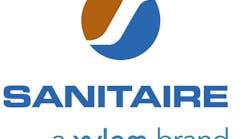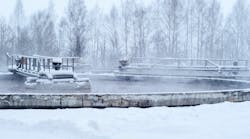St. Joseph Sanitary District No. 1, near La Crosse, Wisconsin, operated a wastewater treatment plant (WWTP) that served approximately 1,000 residential customers. With obsolete equipment and a growing population making it increasingly difficult to achieve state-mandated effluent water quality levels, the district decided to construct a new facility designed to meet tighter permit requirements, including specific effluent concentrations of BOD, TSS, ammonia, total nitrogen (TN), and fecal coliform levels in the treated water.
Solution
The district’s consulting engineer selected Sanitaire’s Intermittent Cycle Extended Aeration System (ICEAS®) treatment process with sequencing batch reactor (SBR) technology for its flexibility, cost-effectiveness, and ability to meet rigorous effluent standards. The ICEAS SBR system accomplishes the secondary treatment process steps – including aeration, settle, and decant – in a single tank, which saves space compared to conventional treatments requiring separate tanks and return sludge facilities.
Sanitaire worked with the utility’s consulting engineer to ensure the treated water would meet the facility’s permit requirements. Therefore, the ICEAS SBR system was designed to achieve high-quality effluent requirements, including biochemical oxygen demand (BOD)/total suspended solids (TSS) of 10/10 milligrams per liter (mg/L) or less, total nitrogen (TN) to 4 mg/L or less, and total phosphorus (TP) of 1.0 mg/L or less.
The ICEAS SBR system is not only capable of consistently meeting the requirements for treated water quality, it is also built for ease of operation. To coordinate equipment operation throughout all treatment cycle phases, the SBR technology incorporated with the plant’s existing programmable logic controller (PLC) and a supervisory control and data acquisition (SCADA) system, giving plant engineers the ability to change control set points.
Results
Reliable performance and remote monitoring have helped the St. Joseph WWTP maintain continuous operation, while the integrated automation control system will help the utility accommodate a growing population and any future technology upgrades.
Since its completion in January 2007, the St. Joseph WWTP has consistently exceeded the water quality standards set by the Wisconsin Department of Natural Resources. The plant is operating well within the regulated discharge permit requirements set by the state and currently produces effluent values in the single digits.
Editor's Note: Scranton Gillette Communications and the SGC Water Group are not liable for the accuracy, efficacy and validity of the claims made in this piece. The views expressed in this content do not reflect the position of the editorial teams of Water & Wastes Digest, Water Quality Products and Storm Water Solutions.



